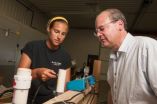(Press-News.org) New research from Western University, Canada, has identified a potential new target for the treatment of melanoma, the deadliest of all skin cancers. Silvia Penuela and Dale Laird discovered a new channel-forming protein called Pannexin (Panx1) that is expressed in normal levels on the surface of healthy skin cells. But they found, in melanoma, Panx1 is over-produced to a pathological level. The researchers also discovered that if you reduce it or knock it down, the cell becomes more normal. The research is published in the August 17th issue of the Journal of Biological Chemistry.
Malignant melanoma only accounts for four per cent of all skin cancers and yet, it's responsible for 79% of skin cancer-related deaths. The World Health Organization says there are 200-thousand cases of melanoma diagnosed each year and 65 thousand melanoma-related deaths (2000 statistics).
"We think this over-production of Panx1, enables the melanoma to become very aggressive. The cells have these extra Panx1 channels and they can leave the primary tumor and invade other tissues," explains Laird, a Professor in the Department of Anatomy and Cell Biology, and Canada Research Chair in Gap Junctions and Disease. "And when you find a protein that is highly up-regulated in a disease cell such as a melanoma, the question becomes, is there therapeutic value in targeting a drug to that protein to reduce its production or block its function. Would that be an effective treatment?"
"We now want to correlate our discovery to patient samples using the human melanoma bank through our collaboration with Dr. Muriel Brackstone and other clinicians at the London Health Sciences Centre, to see if this is a cancer marker," says Penuela, a Postdoctoral Fellow working in the Laird lab. "So if a melanoma lesion has a lot of this protein, it might be a tool for prognosis, in saying this is more advanced, or going to be highly metastatic. And because it's on the skin, it would be more accessible for treatment." Penuela suggests potential treatment might be in the form of a topical medication to use on melanoma lesions.
The scientists also worked with David Litchfield and John Lewis and their teams at Schulich Medicine & Dentistry and the London Regional Cancer Program on this research. It was funded through the Canadian Institutes of Health Research. The Laird laboratory recently received a $200,000 Innovation Grant from the Canadian Cancer Society Research Institute to further its studies on Panx1.
INFORMATION:
Potential new treatment target identified for melanoma skin cancer
2012-08-15
ELSE PRESS RELEASES FROM THIS DATE:
Acute stress alters control of gene activity
2012-08-15
Acute stress alters the methylation of the DNA and thus the activity of certain genes. This is reported by researchers at the Ruhr-Universität Bochum together with colleagues from Basel, Trier and London for the first time in the journal Translational Psychiatry. "The results provide evidence how stress could be related to a higher risk of mental or physical illness", says Prof. Dr. Gunther Meinlschmidt from the Clinic of Psychosomatic Medicine and Psychotherapy at the LWL University Hospital of the RUB. The team looked at gene segments which are relevant to biological ...
Danger in the blood: U-M scientists show how antibiotic-resisting bacterial infections may form
2012-08-15
New research may help explain why hundreds of thousands of Americans a year get sick – and tens of thousands die – after bacteria get into their blood. It also suggests why some of those bloodstream infections resist treatment with even the most powerful antibiotics.
In a new paper in the Journal of Infectious Diseases, a team of University of Michigan researchers demonstrate that bacteria can form antibiotic-resistant clumps in a short time, even in a flowing liquid such as the blood.
The researchers made the discovery by building a special device that closely simulates ...
School food -- on the front line in the fight against childhood obesity
2012-08-15
New Rochelle, NY, August 15, 2012—Childhood Obesity, a peer-reviewed journal from Mary Ann Liebert, Inc., publishers, has published a special issue dedicated to the role that schools can and should play in providing and encouraging healthy nutrition and good eating habits to help stem the tide of the obesity epidemic in children and adolescents. The special issue provides comprehensive coverage of food policy, systems, and programs to improve food culture, practices, and nutrition standards in the school environment, and is available free on the Childhood Obesity website ...
By studying animal health, researchers find improved ways for developing, testing cancer therapies
2012-08-15
MANHATTAN, KAN. -- A group of Kansas State University researchers has made valuable findings in the search for cancer's cure.
While researching ways to improve animal health, the scientists -- Raymond "Bob" Rowland, a virologist and professor of diagnostic medicine and pathobiology, and Deryl Troyer, professor of anatomy and physiology --have made two important discoveries that can also improve human health. Not only have they found pigs with severe combined immunodeficiency, or SCID, but they are also the first to discover the connection with human cancer, particularly ...
Doing the math to fight childhood obesity
2012-08-15
Dieters often use online calorie calculators to stay true to their weight-loss plan. Translating the concept to the population health arena, researchers at Columbia University's Mailman School of Public Health created the Caloric Calculator to help policymakers, school district administrators, and others assess the potential impact of health policy choices on childhood obesity.
Select a target population (middle-school-age boys, for example) and the Caloric Calculator tells you the percentage of this group who are obese (18%) and the average daily calorie cuts necessary ...
A nonantibiotic approach for treating urinary tract infections
2012-08-15
WASHINGTON, Aug. 15, 2012 — The latest episode in the American Chemical Society's (ACS') award-winning Global Challenges/Chemistry Solutions podcast series describes a potential new approach for treating urinary tract infections (UTIs) — which affect millions of people annually — without traditional antibiotics. Because it involves non-antibiotic compounds, the approach would not contribute to the growing problem of antibiotic-resistant bacteria, or "superbugs."
Based on a report by Beat Ernst, Ph.D., and colleagues in ACS' Journal of Medicinal Chemistry, the new podcast ...
American Chemical Society launches 2012 edition of popular Prized Science video series
2012-08-15
WASHINGTON, Aug. 15, 2012 — Progress toward developing an alternative to organ transplantations in which doctors could actually grow a new heart or liver for a patient is among the topics in the 2012 premier of a popular video series from the American Chemical Society (ACS), the world's largest scientific society. The videos are available at www.acs.org/PrizedScience and on DVD.
Titled Prized Science: How the Science Behind American Chemical Society Awards Impacts Your Life, the first episode of the 2012 series features the research of Dr. Robert Langer, winner of the ...
Recreating a slice of the universe
2012-08-15
VIDEO:
This computer animation, created using new software called Arepo, simulates nine billion years of cosmic history. Arepo can accurately follow the birth and evolution of thousands of galaxies over billions...
Click here for more information.
Scientists at the Harvard-Smithsonian Center for Astrophysics (CfA) and their colleagues at the Heidelberg Institute for Theoretical Studies (HITS) have invented a new computational approach that can accurately follow the birth and ...
New method to remove phosphorous from wastewater
2012-08-15
EAST LANSING, Mich. — A professor at Michigan State University is part of a team developing a new method of removing phosphorous from our wastewater – a problem seriously affecting lakes and streams across the country.
In addition, Steven Safferman, an associate professor of biosystems and agricultural engineering, and colleagues at Columbus, Ohio, based-MetaMateria Technologies, are devising a cost-effective way of recovering the phosphorous, which then can be reused for fertilizer products.
Although its use is regulated in many states, including Michigan, in items ...
PETA addresses USDA's TABST exemption policy plans
2012-08-15
In public comments submitted yesterday, People for the Ethical Treatment of Animals (PETA) applauds the United States Department of Agriculture (USDA) Center for Veterinary Biologics (CVB) for announcing its plans to allow firms to secure exemptions from the target animal batch safety tests (TABST) that have until now been required for each batch of veterinary biologics products, including live and inactivated vaccines. In draft memorandum 453, USDA states that CVB intends to consider TABST exemptions in line with recommendations in the TABST waiver guideline drafted by ...



